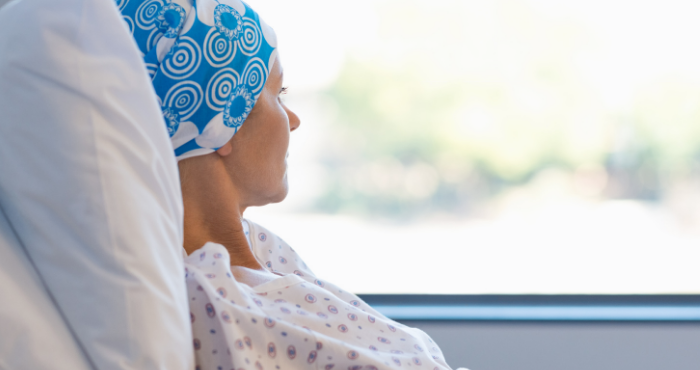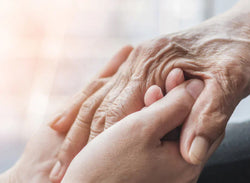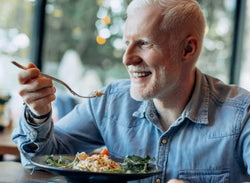
Written by Adele Hug, Specialist Oncology Dietitian. Peer Reviewed by Harriet Smith, RD. Claire James, RD. & Gemma Fry, RD.
Oncology
Learning Objectives:
By the end of this article, you should:
- Be aware of signs and symptoms, diagnosis and treatment options for patients with cancer
- Understand the physical, psychological and nutritional impact of cancer on a patient
- Be aware of nutritional strategies used with patients with cancer
Background Information
Introduction
The term ‘cancer’ refers to a group of diseases that occur when abnormal cells divide in an uncontrolled way.1 Cancer can occur in almost any tissue type due to its ability to grow and invade healthy tissue. It can also spread to other parts of the body in a process known as metastasis. There are over 200 types of cancer and these include carcinomas, lymphomas, leukaemias, sarcomas and brain/spinal tumours.
Key Statistics
One in two people will develop cancer within their lifetime.2 In 2018, an estimated 9.6 million deaths were attributed to cancer, making it the second leading cause of death worldwide.1 In the UK, there were 2.5 million people living with cancer in 2015, and this is estimated to rise to four million by 2030.3 The majority of cases are in older adults (aged over 65) and this is expected to treble by 2040.4 This older cohort of cancer patients are prone to numerous comorbidities.
Signs and Symptoms
The signs and symptoms of cancer are extremely broad. Many of the signs and symptoms overlap with other conditions and diseases, which can cause delays in cancer diagnosis. Different types of cancers have specific signs and symptoms.
Generally-speaking, common signs and symptoms of cancers may include:5,6
- Pyrexia (raised temperature)
- Cough, breathing problems or voice changes
- Dysphagia
- Breast, nipple or chest changes
- Unexplained weight changes
- Fatigue and tiredness
- Abnormal moles
- Skin changes, lumps or swellings
- Mouth ulcers
- Gastrointestinal changes
- Urgency
- Diarrhoea
- Melena (black, tarry stools)
- Reflux and indigestion
- Bloating, distention, obstruction
- Bleeding or bruising problems
- Haematuria (blood in urine)
- Haemoptysis (coughing up blood)
- Vaginal bleeding (post-menopausal bleeding or bleeding after sex)
- Anaemia
- Pain
Screening
Screening aims to identify a disease in asymptomatic individuals within a population.7 Population screening remains controversial due to the possibilities of overdiagnosis and therefore overtreatment. It is continuously evaluated to ensure that the benefits outweigh these risks. In the UK, there are government-led population-wide cancer screening programmes for bowel cancer, breast cancer and cervical cancer. Additionally, high-risk groups or individuals may be referred for screening for certain cancers such as lung cancer8 or prostate cancer.9
Diagnosis
A cancer diagnosis is often made using a combination of diagnostic tools. This may include scans (such as computerised tomography (CT) scans and magnetic resonance imaging (MRI) scans), investigative procedures (such as endoscopy or colonoscopy) and biochemical tests. Detecting specific genetic mutations and tumour-specific receptor expressions are now part of diagnostics to determine if a targeted cancer treatment could be used.
The cancer is commonly classified and staged using the Tumour, Node, Metastasis (TNM) classification.10 This is a globally recognised system for classifying the extent of spread of cancer. The TNM classification system may be used alongside tumour receptors or genetic testing to give an overall clinical picture, predict prognosis and determine the best treatment protocol. Early diagnosis is a key factor in cancer survival11 and delays in diagnosis could be a reason for UK cancer survival rates lagging behind other European countries.12
Treatment Overview
Cancer treatments can be used alone or as a combination. Common treatments may include:
- Surgery
- Chemotherapy
- Radiotherapy
- Hormone therapies
- Targeted therapies
- Immunotherapies
- Stem cell and bone marrow transplants
The Impact of Cancer
The disease itself and its associated treatments can greatly affect the lives of the patient and their carers. This section will explore the physical, psychological and nutritional impacts of cancer.
Physical Impact
Common effects of cancer include biochemical changes (such as anaemia and raised bilirubin), anatomical changes (such as a stoma formation or a mastectomy) and physiological changes (such as sexual dysfunction and fatigue). These physical changes can have a significant impact on a patient’s mental health and body image too.
Cancer treatments can also cause long-term side effects (sometimes referred to as ‘late effects of cancer treatment’). For example, in the long-term, treatments like radiotherapy, systemic anti-cancer treatments (SACT) such as chemotherapy or immunotherapy and hormone therapies can increase the risk of cardiovascular disease, osteoporosis, secondary primary cancer, chronic fatigue, pain, urinary or gastrointestinal problems.13
Psychological Impact
The uncertainty surrounding a cancer diagnosis and its treatment can cause a range of psychosocial issues. Cancer patients report isolation, depression, anxiety and body image issues.14,15 Due to the Covid-19 pandemic, many cancer patients are needing to self-isolate or shield, which could be a cause of additional stress and anxiety, although the long-term impact of the Covid-19 pandemic on cancer patients is largely unknown.16
Nutritional Impact
All of the above can affect a patient’s nutritional status. At diagnosis, some patients may present with signs and symptoms that affect their nutritional status (such as dysphagia, reflux or poor appetite). These are referred to as ‘nutrition-impact symptoms’ (NIS). Other cancer patients may feel relatively well at diagnosis but their cancer treatments (such as SACT and radiotherapy) may cause new NIS.
Malnutrition
The prevalence of malnutrition in cancer patients is highly variable. Recent studies suggest that the prevalence is around 51% to 71%.17,18 Malnutrition in cancer patients is associated with increased morbidity and mortality, decreased treatment tolerance and quality of life and increased hospital admissions.19,20
Cancer Cachexia
Cancer cachexia is a complex and progressive syndrome of systemic inflammation and catabolic alterations. It is characterised by the loss of skeletal muscle mass, with or without loss of fat mass, in those with cancer. It can lead to decreased physical activity, adverse psychological side effects, poor performance status and higher mortality rates (21).
Cancer cachexia is defined by the percentage weight loss from usual body weight. Specifically, a weight loss greater than 5% or weight loss greater than 2% in individuals with a Body Mass Index (BMI) <20 kg/m2 or skeletal muscle mass loss.22 This skeletal muscle mass loss and decline in functional status is known as sarcopenia.
Nutritional Strategies
Nutrition Risk Screening
The prevalence of cancer is increasing and it has a significant effect on a cancer patient’s nutritional status. Oncology dietetic services must prioritise those requiring dietetic support and therefore it is important to identify these patients through regular nutrition risk screening. Early nutrition and dietetic interventions are crucial for supporting improved patient outcomes.
Recent European Society for Clinical Nutrition and Metabolism (ESPEN) guidelines suggest that nutritional risk screening should be performed at the time of a cancer diagnosis, however there is a low level of evidence to support this recommendation.23 Numerous screening tools have been developed and the Patient-Generated Subjective Global Assessment (PG-SGA) is considered a gold-standard nutrition risk screening tool in oncology, with the added benefit of reporting the presence of NIS.24 Currently, there are a lack of screening tools which assess cachexia, sarcopenia and malnutrition at once.25
Prehabilitation
In recent years, prehabilitation (prehab) has been incorporated into cancer treatment pathways. Prehab is a multidisciplinary team (MDT) approach for pre-treatment health optimisation which addresses fitness levels, nutritional status and mental health status. It is increasingly recognised that health optimisation prior to commencing cancer treatments can improve outcomes, including nutritional status, mental health and long-term health.26
Whilst the use of prehab is more established in surgical patients 27, an appropriate personalised programme is recommended for all cancer patients ongoing any treatment, including those undergoing systemic anti-cancer therapies (SACT) or those on a palliative treatment pathway who have an incurable but treatable cancer.26 Prehab can form part of established dietetic services or it may be offered as a standalone service.
Nutrition Support
Whilst some studies have suggested that energy requirements may increase for cancer patients, ESPEN assume similar energy requirements to healthy individuals; however they do recommend slightly higher protein requirements at 1-1.5g protein/kg/day.23 This, coupled with a possible decreased oral intake, reiterates the importance of nutrition support from Registered Dietitians.
Dietetic Counselling
The aims of dietetic counselling are to provide individualised nutritional support which helps to:
- Prevent (further) weight loss
- Maintain muscle mass
- Prevent treatment delays due to nutritional issues
- Enhance quality of life whilst upholding a patient’s cultural beliefs.
An individualised and person-centred approach is key.28 A food-first approach is prioritised in patients who are able to eat and drink orally.29 This approach may involve:
- Offering food ‘little but often’ in smaller portions
- Food fortification with high energy/protein options
- Offering favourite foods and preferred flavours
- Encouraging consumption of nourishing drinks between meals
- Offering encouragement and support
However, if patients are struggling to meet their nutritional requirements through an oral diet alone and/or if the patient has or is at risk of malnutrition, they may be prescribed oral nutritional supplements (ONS). Some patients are unable to eat and drink orally and therefore nutrition may be delivered via the enteral route or via the parenteral route to supplement or provide full nutrition requirements when appropriate.30
Dietitians play key roles in multidisciplinary care teams. They serve as advocates for their patient’s nutritional needs throughout their cancer journey. For example, head and neck patients should receive dietetic support and advice from dietitians regarding the best enteral feeding routes to meet their nutritional requirements during chemoradiotherapy31,32
Texture and Fibre Modification
Patients may need a texture modified diet due to the disease and/or treatment causing symptoms (i.e. dysphagia) which make safe swallowing more difficult. Texture and fibre modified diets are often used for the management of inoperable malignant bowel obstruction (MBO), although the evidence base for this is limited.33 There is an ongoing clinical trial looking at the use of an elemental diet (ONS consisting of amino acids, fatty acids, sugars, vitamins and minerals that require no digestion) in patients with ovarian MBO.34 The types of dietary fibres consumed may also be manipulated for bowel management; for example, patients with an ileostomy may be counselled to follow a low insoluble fibre diet.35
Symptom Management
Appropriate symptom management forms a crucial part of dietetic treatment for oncology patients. Table 1 provides an overview of the causes and management strategies for Nutrition Impact Symptoms (NIS) in cancer.
Table 1: The causes and management strategies for Nutrition Impact Symptoms (NIS) in cancer36,37
|
NIS |
Various causes |
MDT Solutions |
Nutritional strategies (in addition to dietetic counselling) |
|
Loss of appetite (anorexia) |
Many systemic anticancer treatments (SACT) Radiotherapy Nausea Constipation Anxiety Cancer cachexia End of life / terminal disease phase |
Medications: Corticosteroids steroids Progestins (megestrol acetate & medroxyprogesterone acetate) Nausea: antiemetic Constipation: laxatives Alcohol (appetite stimulant)
Mental health support |
Oral nutrition support and appropriate ONS prescribing |
|
Nausea and vomiting (N&V) |
SACT RT Constipation Post-surgery Anxiety Sub-acute or acute bowel obstruction |
Antiemetics
Treat cause – e.g. laxatives, medication alterations (timing, type and dose), bowel obstruction
Mental health support |
Oral nutrition support and appropriate ONS prescribing
Some emerging evidence for the use of ginger for chemotherapy-induced N&V,38 but more research is needed |
|
Taste changes – can be described as “cardboard”, “metallic”, no taste, increased sensitivity |
Very common due to SACT
RT (especially head and neck RT patients) |
Limited |
Add more or less flavour to food
Focus on easier to eat flavours (may be bland, sweet, tart) Offer different ONS flavours
Use plastic cutlery for metallic tastes (Limited evidence)39 |
|
Mucositis (inflammation/ ulceration in the gastrointestinal system, called stomatitis in the mouth) |
SACT
Dry mouth
Oral/oesophageal candida |
Blood glucose check and appropriate treatment
Good oral hygiene
Mouthwashes
Topical coating
Anti-fungal treatment |
Oral nutrition support and appropriate ONS prescribing
Adequate hydration
Texture modification
EN or PN in extreme cases |
|
Dysphagia |
RT
Cancer itself
End of life |
Oesophageal dilation
Oesophageal stent |
Texture modification
Oral nutrition support and appropriate ONS prescribing
EN – prophylactic / reactive PN in extreme cases |
|
Constipation |
Opiate-based analgesia
Specific 5HT3-receptor antagonist such as ondansetron can cause constipation 40 |
Laxatives |
Increase fibre
Adequate hydration fluid intake
Optimise physical activity (unlikely to have a significant effect) |
|
Diarrhoea |
SACT
Pelvic/abdominal RT
Immunotherapy-induced colitis
Malabsorption (steatorrhoea)
Bile acid diarrhoea (BAD)
Faecal loading with overflow |
Anti-diarrhoeal (e.g. loperamide, codeine phosphate)
Corticosteroids
SACT/RT dose reduction
New MDT guidelines for immunotherapy induced colitis41
Pancreatic enzymes replacement therapy (PERT)
Bile acid sequestrant
High dose laxatives |
Optimising medications/bile acid sequestrant/PERT optimisation and timings
Low fibre diets are not indicated in most cases including pelvic RT42
Support if previous IBS/IBD diagnosis
Low-lactose trial (usually transient)43
Adequate hydration/ isotonic drinks (if indicated)
PERT optimisation
Low fat diet if indicated and appropriate for BAD |
|
Hyperglycaemia |
Uncontrolled diabetes
Undiagnosed diabetes
Steroid-induced hyperglycemia/ diabetes |
Appropriate hypoglycemic medications |
Traditional “diabetes diet” usually not appropriate in these cases
Carbohydrate awareness may help
Appropriate guidance on hypoglycemia management if at risk |
|
Pain |
Disease location
Surgery
RT
Constipation |
Adequate analgesia
Treat cause (if able) |
Pain relief before meals if pain with eating/drinking
Pain itself can cause anorexia so reassure patient adequate pain control can improve intake |
|
Depression and/or anxiety |
Diagnosis
Treatments
Disease progression |
Medications
Appropriate therapy |
Realistic nutrition goals
Self-care through eating and drinking
Optimise intake to meet person-specific needs |
End of Life Nutritional Care
Patients with refractory cachexia are only able to make limited improvements to their physical health and nutritional status. As a patient nears the end of their life, the aims of nutrition support may change to ensure optimal quality of life. The dietitian plays an important role in helping to advise on appropriate dietary strategies. Early discussions with the patient, their carers and the MDT are crucial for appropriate person-centred nutritional care.44
Alternative Diets
When patients are undergoing cancer treatment, nutrition can often feel like the only thing that they have control over. However, it is important to recognize that, whilst important, nutrition alone cannot cure cancer. Some patients may choose to reject conventional cancer treatment and nutritional support in favour of alternative and non-evidence-based dietary and treatment approaches. This has been associated with an increased risk of death (45), so it is important that all healthcare professionals (including dietitians) are empathetic and explore their patient’s belief system when discussing appropriate nutrition support.
Section 4: Useful Resources
Cancer Charities for Cancer Information:
Young Adult Cancer Support -Trekstock
Guidelines on Clinical Practice:
Peer Support and Education:
BDA Specialist Oncology Group
To complete CPD questions on this resource















